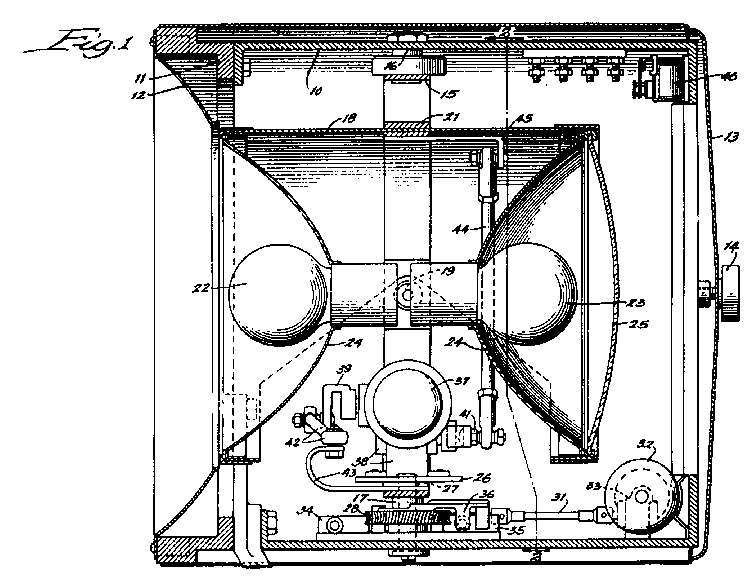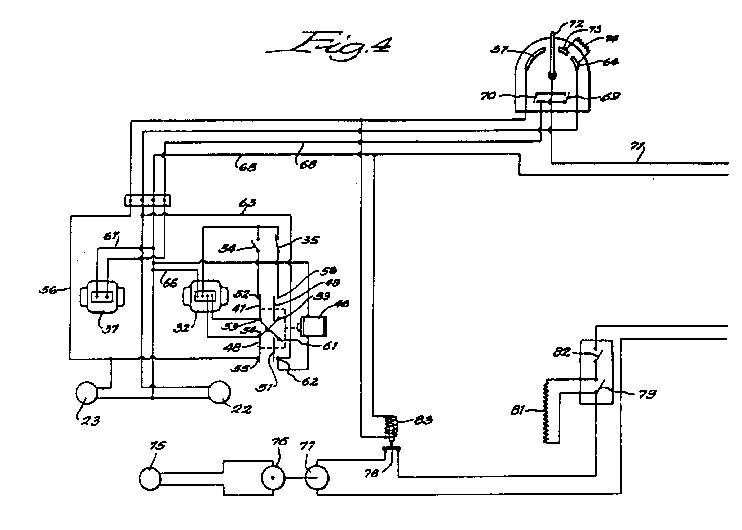This website has been archived from TrainWeb.org/gyra to TrainWeb.US/gyra.
This website has been archived from TrainWeb.org/gyra to TrainWeb.US/gyra.



This light device is for a railway locomotive or other railway cars in which 2 selectively
operable light sources are provided. One of the light sources is a white light utilized
during normal running while the other is a red colored light which is utilized to signal
approaching trains or for other warning purposes.
The normal running light of the locomotive or railway car is interrupted (extinguished)
when the colored beam of the device is operated. This enhances the effect of the colored
beam.
Figure 1 is an axial section.
Figure 2 is a transverse section on line 2-2 of Figure 1.
Figure 3 is a partial section on line 3-3 of Figure 1.
Figure 4 is a wiring diagram for this device.
The device illustrated is composed of a main frame 10 which is generally "U-
shaped" and which is connected at one end to a ring 11 supporting an annular
reflector 12 through which the projected light beam passes.
The main frame 10 is preferably covered by a housing 13 which fits
against the ring 11 and secured to the rear of the main frame 10 by a
screw 14.
The reflector 12 may be covered by a suitable glazed cover or lens, if
desired.
A subframe 15 is pivotally mounted in the main frame10 on opposed pivots 16 and 17 which define an axis transverse to the length of the main frame 10. Within the subframe 15 is a lamp support 18 mounted on pivots 19 lying on an axis transverse to the axis of the pivots 16 and 17.
A pair of electric lamps 22 and 23 are supported in support 18. These lamps face opposite ends and lie within reflectors 24. The lamp 23 is adapted to project a beam having a color such as red. For this purpose, a tinted transparent cover 25 may be secured over its reflector 24.
The plate 26 carries a motor 37 which drives a gear box 38 from which two cranks 39 and 41 are connected. The crank 39 is connected through a link 42 to a bracket 43 which is secured to a subframe 15 so that as the crank 39 turns, the subframe will be oscillated about pivots 16 and 17. The crank 41 is similarly connected via a link 44 to a bracket extension 45 on the support 18 so that as crank 41 turns, the support will be oscillated about the pivots 19. By properly adjusting the throws of the cranks 39 and 41, any desired motion of the support may be produced such as the "figure 8" movement which is normally used in signal devices of this type.
The reversible motor 32 is controlled by a relay 46 which operates a plurality of switch blades 47, 48, 49, and 51.
Figure 4 illustrates the power supply circuit for a locomotive headlight. The
headlight 75 is supplied with current from a generator 76 which is driven
by motor 77. The motor 77 is supplied with current through switch
78 and through a dimming switch 79 having a resistance 81 in
shunt and a manual control switch 82. With all the switches closed, the motor
77 will run at relatively high speed to supply maximum voltage to the headlight
75 while with dimming switch 79 open, the resistor 81 will
reduce the voltage output.
The switch 78 is normally closed but can be opened by solenoid 83
which is connected across wires 65 and 56. When arm 72
engages the segment 57 to energize the lamp 23, the solenoid
83 will also be energized to interrupt the circuit to the headlight 75 in
order to make the colored danger signal more readily visible.
For normal running of this light unit, switch arm 72 is moved into contact
with either contact 64 or 73 which energizes lamp 22 and turns
on motor 32 to bring lamp 22 into register with reflector 12.
Limit switch 35 serves to interrupt the circuit to the motor 32 when this
position is achieved. Motor 37 may then be operated to produce oscillation of
the beam, if desired.
Resistor 74 serves as dimming resistor for the use of the regular (clear)
lamp 22.
In order to emit a warning signal, arm 72 is moved into engagement with the
contact 57. The lamp 23 is energized while motor 32 produces
rotation of the plate 26 in the opposite direction due to reversal of current
through the contacts 53 and 54, caused by operation of switch contacts
47 and 48.(Note: When wiper 72 is moved out of contact with
both contacts 64 and 73, the relay 46 will be de-energized to
allow the switch blades to move to the left as shown in Figure 4). At this time the
motor 32 will operate in the reverse direction to turn the plate 26 through
180° causing lamp 23 to be moved into the register with opening in the reflector
12 in order to project a colored beam. Limit switch 34 will open to de-
energize the motor 32 at this position. The motor 37 may be operated by
closing either switch 69 or 70 to cause the light beam to oscillate. One
should note that the reason for the 2 switches for this oscillating mode is that one may be
used for continuous operation while the other for momentary. Use of a momentary
switch could enable the light to be inched into a desired position.
| WR-5000-A Mars Light: | photo |
|---|